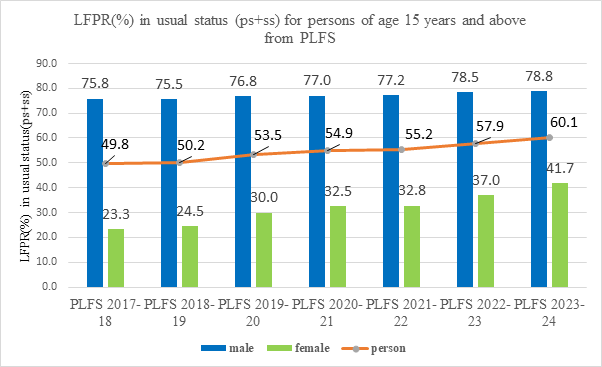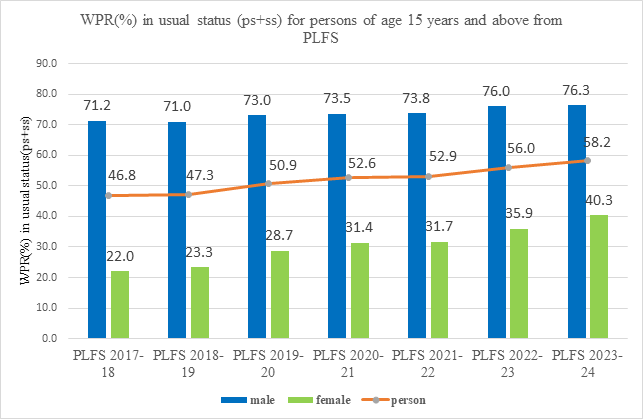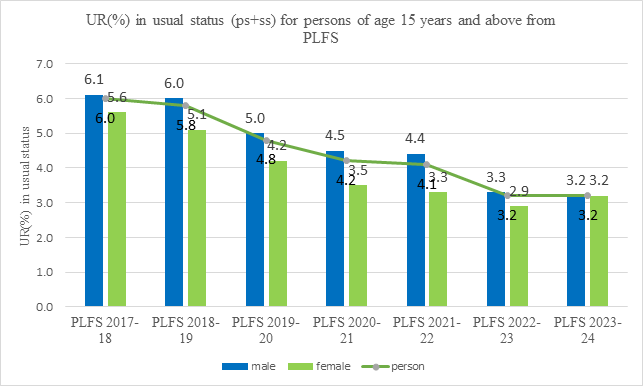Dear Fellow Citizens,
The recently released Periodic Labour Force Survey (PLFS) 2023-24 paints an intriguing picture of India’s labor market. It’s a mix of hope and hurdles, progress and persistence. While we’ve made strides with a declining unemployment rate, the real question remains—are we doing enough to turn these numbers into meaningful change?
How Employment Data is Collected in India
India collects its employment data in a variety of ways, with several key players contributing to the picture.
Here’s a quick breakdown:
- Periodic Labour Force Survey (PLFS): Conducted by the National Statistical Office (NSO), the PLFS provides annual and quarterly estimates of labor force indicators, including employment, unemployment, and participation rates. It covers rural and urban areas, offering comprehensive insights.
- Centre for Monitoring Indian Economy (CMIE): CMIE’s Consumer Pyramids Household Survey collects data on employment trends more frequently than government surveys, providing near-real-time insights. However, its sample size and methodology differ from official sources.
- Employment Exchanges and Industry Reports: Data from employment exchanges, industry reports, and surveys by organizations like the Ministry of Labour and Employment add layers of granularity.
- Census and Economic Surveys: The decadal Census and Economic Surveys also include questions related to employment and livelihoods, providing auxiliary data points.
Each source has its strengths and limitations, but together, they help us piece together the puzzle of India’s complex job market.
Challenges in Measuring Employment Data
Despite these efforts, several challenges persist:
- Informal Sector Dominance: Over 80% of India’s workforce operates in the informal sector, making it difficult to track employment accurately.
- Regional Disparities: Vast economic and cultural differences across states create inconsistencies in data collection.
- Dynamic Workforce Participation: Factors such as migration, seasonal employment, and disguised unemployment blur the lines of measurement.
- Gender Disparities: Women’s workforce participation is often underreported due to socio-cultural norms.
”We can win respect in the world only if we are strong internally and can banish poverty and unemployment from our country.
Lal Bahadur Shastri (2nd Prime Minister of India: 1964-1966)This sentiment underscores the importance of reliable employment data.
Interpreting Employment Data: Key Indicators
- Labour Force Participation Rate (LFPR): This measures how many people are in the labor game—working, looking for work, or ready to roll—compared to the total population. Basically, it’s the “who’s in?” stat.
- Worker Population Ratio (WPR): This tells us the percentage of people who are actually working. Think of it as the “who’s got their sleeves rolled up?” metric.
- Unemployment Rate (UR): The UR reveals how many folks in the labor force are out of work. It’s the “job search blues” indicator.
- Current Weekly Status (CWS): This checks what people were up to in the job market over the last 7 days. It’s like a quick snapshot of their work week.
”"Providing gainful employment to the youth of India is not just an economic imperative; it is our moral obligation."
Dr. Manmohan Singh (Prime Minister of India: 2004-2014)
The survey brings good news: India’s unemployment rate is at a six-year low of 3.2%. That’s a number worth celebrating. But let’s not stop there. The participation of women in the workforce, at just 34%, is still alarmingly low compared to global standards. This isn’t just a statistic—it’s a reflection of the systemic barriers women face daily, from safety concerns to lack of childcare support.
And while urban youth unemployment has decreased, it still hovers around 8.5% for the 15-29 age group. For a nation with such a vibrant and talented youth population, this signals a gap between education and employability. Are we truly equipping our young minds with the skills they need for the jobs of tomorrow?
The optimism from the survey is tempered by the harsh reality of layoffs. In 2023, companies like Byju’s and Wipro let go of thousands of employees. Byju’s reportedly laid off over 4,000 people, and Wipro downsized by around 2,000. These numbers are not just statistics—they’re stories of individuals, families, and communities affected by economic uncertainty.
In 2024, 2,60,000 individuals were laid off by 1200 companies in India. However this is a 42% decline in layoffs when compared to 2023. Some more good news!
Agriculture, construction, and e-commerce have been pillars of mass employment. Companies like Flipkart and Amazon expanded their workforce to meet growing consumer demand. Government schemes like MGNREGA also stepped up, providing vital support for millions through infrastructure projects in rural areas.
Amidst these challenges, some businesses have shown what’s possible. Reliance Retail grew its workforce to nearly 400,000 employees, proving that strategic expansion can create opportunities. Infosys, through its focus on reskilling (and 70 hours work week :P), continued to be a major job provider in the IT sector.
And let’s not forget the countless small and medium enterprises (SMEs) that quietly power our economy, from textiles to food processing to handicrafts. These enterprises are the unsung heroes, offering livelihoods to millions across the country.
Fellow citizens, the numbers from the PLFS report are not just data points. They’re a call to action. We must:
- Champion Women’s Participation: It’s high time we create workplaces that are inclusive, safe, and supportive for women. Whether it’s offering flexible work options or ensuring better childcare facilities, every step counts.
- Bridge the Skills Gap: Initiatives like the Pradhan Mantri Kaushal Vikas Yojana (PMKVY) are a start, but we need to go further. Let’s equip our youth with skills in cutting-edge fields like AI, robotics, and renewable energy.
- Protect Workers’ Rights: Job creation means little without fair wages, humane working conditions, and job security. Companies must lead by example and ensure dignity for all workers.
- Empower Local Entrepreneurs: Rural startups and grassroots innovators have the potential to be game-changers. With the right financial support and mentorship, they can create localized jobs and drive community growth.
The government, businesses, and we, the people, must come together to ensure that growth reaches every corner of the nation. Layoffs and inequalities are not just economic issues—they’re societal challenges that need collective action.
Imagine an India where every individual, irrespective of gender, location, or background, has a fair shot at success. It’s not a dream; it’s a possibility. But it requires us to act—boldly and decisively.





